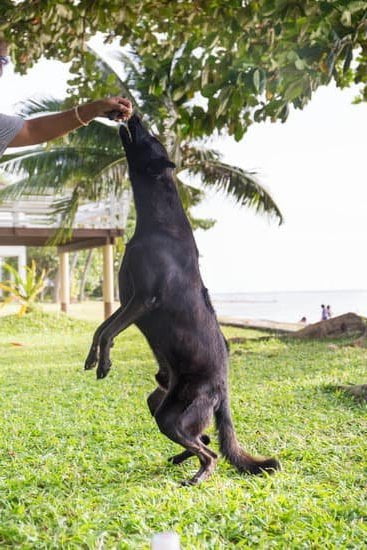Training your dog to wear diapers is an essential skill for many pet owners. Managing a dog’s bathroom needs can be challenging, but with the right training, it becomes much easier. In this article, we will explore the importance of training your dog to wear diapers and the benefits it provides. With step-by-step instructions and helpful tips, you’ll be equipped to navigate this training process successfully.
One of the common challenges that dog owners face is managing their pet’s bathroom habits. Whether it’s dealing with incontinence or females in heat, accidents can be messy and time-consuming to clean up. That’s where training your dog to wear diapers comes in handy. By teaching your furry friend to willingly wear diapers, you can minimize accidents and make clean-up a breeze.
Training your dog to wear diapers also has additional benefits beyond convenience. It promotes cleanliness and hygiene in your home by containing any messes within the diaper. Moreover, it helps prevent potential health issues caused by accidents, such as infections or skin irritation. With the goal of providing you with comprehensive instructions on how to train your dog to wear diapers, let’s dive into each step of the process together.
Assessing the Need
Many dog owners may find themselves in situations where managing their pet’s bathroom needs becomes challenging. Whether it’s dealing with an incontinent pet or a female dog in heat, finding a solution that ensures cleanliness and convenience is crucial. This is where training your dog to wear diapers can be incredibly beneficial. Before diving into the training process, it’s important to assess whether your dog would benefit from wearing diapers.
To determine if your dog is a good candidate for diapers, there are a few factors you should consider. First, evaluate the specific circumstances that necessitate the use of dog diapers. For example, if your senior dog is experiencing urinary or fecal incontinence, diapers can help prevent accidents and keep both your home and your furry friend clean and comfortable.
Additionally, female dogs that are in heat can benefit from wearing diapers to manage any discharge or mess during this time. Diapers provide a practical solution to contain and control these bodily fluids, reducing the stress associated with managing this natural biological process.
Aside from specific situations, it’s essential to assess any underlying behavioral or medical issues that could be contributing to the need for diapers. If your dog is frequently urinating outside of designated areas or experiencing sudden changes in bathroom habits, consult with a veterinarian before considering the use of diapers. It’s crucial to rule out any potential health concerns or discomfort that may require treatment instead.
Selecting the Right Diapers
When it comes to training your dog to wear diapers, one of the most important steps is selecting the right type of diaper. Just like with human diapers, there are various styles and types of dog diapers available in the market. Understanding the different options will help you make an informed decision based on your dog’s needs and preferences.
Disposable diapers are a popular choice for many dog owners due to their convenience. These diapers are designed for one-time use and can be easily discarded after each wear. They often come with adhesive tabs or straps that allow for easy adjustments and secure fit. Disposable diapers are available in a range of sizes, making it easier to find the perfect fit for your furry friend.
On the other hand, reusable diapers offer a more environmentally friendly option. These diapers can be washed and reused multiple times, saving you money in the long run. Reusable diapers often come with adjustable straps or Velcro closures, allowing for a customizable fit. It is important to note that not all dogs may tolerate wearing reusable diapers as they may feel bulkier compared to disposable ones.
When choosing between disposable and reusable options, consider factors such as your budget, your dog’s comfort level, and any skin sensitivities they may have. It may also be helpful to consult with your veterinarian for recommendations based on your dog’s specific needs.
| Disposable Dog Diapers | Reusable Dog Diapers |
|---|---|
| Convenient | Eco-friendly |
| Easy to use | Cost-effective in the long run |
| Wide range of sizes available | Can be customizable for a better fit |
| May be more comfortable for some dogs | May feel bulkier for some dogs |
| May cause skin irritation in some dogs | Requires regular washing and maintenance |
Remember that the right size and fit are crucial regardless of the type of diaper you choose. Make sure to measure your dog’s waist circumference accurately and refer to the manufacturer’s sizing guide for a proper fit. An ill-fitting diaper can cause discomfort or leakage, defeating the purpose of training your dog to wear diapers.
By understanding the different types of dog diapers and considering your dog’s individual needs, you can select the right diapers that will not only keep accidents at bay but also ensure your furry friend feels comfortable throughout their diaper-wearing journey.
Familiarizing Your Dog with Diapers
Step 1: Create a Positive Association
The first step in familiarizing your dog with diapers is to create a positive association with them. Start by introducing the diapers to your dog in a calm and controlled environment. Place a clean diaper near your dog’s favorite spot or where they usually sleep. Allow your dog to approach and investigate the diaper at their own pace.
To further reinforce the positive association, consider using treats or praise when your dog interacts with the diapers. For example, you can reward them with their favorite treat when they sniff or touch the diaper. This will help your dog associate the presence of diapers with something enjoyable and rewarding.
Step 2: Gradual Exposure
Once your dog has developed a positive association with the diapers, it’s time to gradually expose them to actually wearing the diaper. Begin by placing it on your dog for just a few seconds, while still providing treats or praise as positive reinforcement. Increase the duration gradually over several training sessions.
It’s important to closely monitor your dog’s behavior during this process. If they show signs of discomfort or resistance, take a step back and go at a slower pace. You might need to repeat previous steps until your dog becomes more comfortable.
Step 3: Proper Fit
During the familiarization process, it’s crucial to ensure that the diaper fits properly and is comfortable for your dog. Diapers that are too tight can cause discomfort or restrict movement, while those that are too loose may not be effective in containing messes.
Choose a diaper size that is appropriate for your dog’s breed and weight, following the guidelines provided by the manufacturer. Make sure that there is enough room for your dog to move comfortably and that it stays securely in place without causing irritation.
By gradually introducing and acclimating your furry friend to wearing diapers in these steps, you’re setting the foundation for successful diaper training. Remember to remain patient and consistent, providing positive reinforcement throughout the process. With time and practice, your dog will become comfortable wearing diapers and you can move on to the next step in the training process.
Step-by-Step Training Process
Now that you have assessed the need and selected the right diapers for your dog, it’s time to start the step-by-step training process to get your furry friend comfortable with wearing diapers. This process requires patience and consistency, but with the right approach, it can be a smooth transition.
- Start in a calm and controlled environment: It’s important to introduce the diapers in a space where your dog feels at ease. Avoid any distractions or loud noises that may cause anxiety. Begin by placing the diapers near your dog and let them explore at their own pace. Remember to stay calm and reassuring throughout this process.
- Properly put on the diapers: Once your dog becomes familiar with the presence of diapers, it’s time to teach them how to wear them. Make sure you have chosen the appropriate size and fit for your furry friend. With gentle encouragement, guide their legs through the leg holes of the diaper and fasten it securely around their waist. Ensure that it is snug enough to stay in place but not too tight to cause discomfort.
- Gradually increase duration: At first, let your dog wear the diaper for short periods of time, gradually increasing the duration as they become more comfortable. Offer treats or rewards to reinforce positive behavior during this process. Keep an eye out for any signs of distress or discomfort, such as excessive scratching or agitation.
- Reward positive behavior: As your dog adjusts to wearing diapers, reward them with praise or treats when they exhibit calmness and acceptance of wearing them. This positive reinforcement will help create a positive association with wearing diapers.
- Monitor behavior and adjust training: Throughout this training process, closely monitor your dog’s behavior for any signs of resistance or discomfort. If you notice any issues, take a step back and assess what might be causing them. It could be related to fit, material, or simply needing more time for adjustment. Adjustments may be necessary in the training process, so be flexible and adapt accordingly.
Remember, each dog is unique, and the training process may vary in duration. Some dogs may adapt quickly, while others may require more time and patience. Stay consistent and positive throughout the process, and always consult with your veterinarian if you have any concerns or questions.
By following these steps, you can help make the process of getting your dog comfortable with wearing diapers a positive experience for both you and your furry companion.
Troubleshooting
Introduction to Troubleshooting
Training your dog to wear diapers is a process that can come with its fair share of challenges. It’s important to remember that each dog is unique and may react differently to wearing diapers. In this section, we will address the common challenges that dog owners may face during diaper training and provide some effective solutions and tips to overcome them.
Resistance and Discomfort
One of the most common challenges when it comes to diaper training is resistance from your dog. Some dogs may not be immediately receptive to wearing diapers and may exhibit signs of discomfort or attempt to remove them. This can be due to unfamiliarity with the sensation of wearing a diaper or a dislike for the restricted movement it might cause.
To address resistance, it is crucial to introduce the concept gradually. Start by allowing your dog to sniff and investigate the diapers before attempting to put them on. Offer treats or praise as positive reinforcement during this initial introduction. Additionally, try using a smaller-sized diaper at first, as it may feel less intrusive for your dog.
If resistance persists, consider making the training sessions shorter initially so that your dog can slowly adjust. Monitor their behavior closely during this time and praise any positive interaction with the diapers. Over time, increase the duration of diaper-wearing sessions gradually until your dog becomes more comfortable.
Leakage and Fit Issues
Another challenge you might encounter is leakage or fit issues with the diapers. Improperly fitting or low-quality diapers can result in accidents and messes around your home. To prevent leakage, ensure that you select the right size for your dog’s specific body shape and weight.
Disposable diapers usually have guidelines on their packaging for selecting the correct size, so refer to those instructions when choosing which one to purchase. If you are opting for reusable cloth diapers, measure your dog’s waist circumference accurately before making a purchase.
If you experience leakage despite using the correct size, try adjusting the fit of the diaper. Make sure it is snug around your dog’s waist without being too tight or uncomfortable. Additionally, consider using an absorbent diaper liner to increase its effectiveness and minimize leakage.
Monitoring Behavior and Adjusting Training
Throughout the training process, it’s essential to closely monitor your dog’s behavior and make necessary adjustments to the training plan. Every dog is unique, so their progress may vary. Pay attention to any signs of discomfort, irritation, or distress exhibited by your dog while wearing diapers.
If you notice any negative reactions, take a step back in the training process and reintroduce the diapers gradually. Modify your approach as needed to ensure your dog feels comfortable and secure while wearing them. It may also be helpful to consult with a professional dog trainer or veterinarian for additional guidance tailored specifically to your dog’s needs.
Remember, patience and consistency are key when troubleshooting common challenges during diaper training. With time and effort, you can overcome these obstacles and successfully train your dog to wear diapers for a cleaner home environment.
Maintaining Hygiene and Diaper Care
When it comes to training your dog to wear diapers, maintaining proper hygiene and diaper care is essential for both your dog’s health and the longevity of the diapers. This section will provide you with some useful tips on how to keep your dog clean and comfortable while wearing diapers.
One of the most important aspects of diaper care is regular changing. Just like humans, dogs need clean diapers to prevent infections, irritation, and unpleasant odors. Depending on your dog’s needs and activity level, you may need to change their diaper every 2-4 hours or more frequently if necessary. It is crucial to check the diaper frequently for any signs of soiling or when it becomes wet.
In addition to regular changing, proper cleaning of the diaper area is also crucial in maintaining hygiene. When changing the diaper, gently clean your dog’s private parts with a mild pet-friendly wipe or warm water and a soft cloth. Avoid using harsh chemicals or wipes that contain fragrances as they can cause skin irritation. Remember to thoroughly dry the area before putting on a fresh diaper to prevent bacterial growth.
To minimize odors and potential skin irritation, consider using diaper liners or pads inside the diaper. These liners can help absorb moisture and control odors, providing additional comfort for your dog. It is also recommended to apply a thin layer of pet-safe barrier cream or ointment around the genital area before putting on a new diaper. This can help protect your dog’s skin from moisture-related irritations and rashes.
| Tips |
|---|
| Regularly change your dog’s diapers every 2-4 hours. |
| Gently clean your dog’s private parts with a mild pet-friendly wipe or warm water and a soft cloth. |
| Thoroughly dry the diaper area before putting on a fresh diaper. |
| Consider using diaper liners or pads to minimize odors and improve absorption. |
| Apply a thin layer of pet-safe barrier cream or ointment around the genital area before putting on a new diaper to prevent skin irritation. |
By following these tips, you can ensure that your dog remains clean, comfortable, and healthy while wearing diapers. Remember, proper hygiene and diaper care are essential for the success of training your dog to wear diapers and maintaining a hygienic living environment for both you and your furry friend.
Gradual Transition
Once you have successfully trained your dog to wear diapers, the ultimate goal is to eventually wean them off diapers altogether. This step-by-step process will help your dog transition back to their natural bathroom habits while maintaining cleanliness in your home.
To start the gradual transition, it is important to assess whether your dog is ready. Look for signs that they are able to control their bladder and bowels, such as consistently indicating when they need to go outside or using a designated potty area. It is also crucial that any underlying medical or behavioral issues have been addressed before attempting this transition.
Begin by gradually reducing the amount of time your dog wears diapers. Start with short periods of time without diapers, monitoring their behavior closely for any accidents. If accidents do occur, continue using diapers during those times until accidents become less frequent.
During the transition period, reinforce positive bathroom habits outside of wearing diapers. Take your dog outside at regular intervals and reward them with treats and praise when they eliminate in the appropriate area. This will help them understand that going outside is the desired behavior.
Consistency is key during this phase. Stick to a consistent schedule for bathroom breaks and gradually increase the time between diaper usage. Keep a close eye on your dog’s behaviors and make adjustments as necessary.
Throughout the process, continue providing positive reinforcement for successful bathroom habits outside of wearing diapers. Use treats, praise, or whatever method works best for your dog to encourage and reward desired behavior. Patience and consistency are essential during this gradual transition period.
Remember that every dog is different, so the length of time it takes for each individual may vary. Be flexible and adjust the pace according to your dog’s progress. With patience and persistence, you will be able to successfully wean your dog off diapers and enjoy a peaceful coexistence in a cleaner home environment.
Transitioning away from wearing diapers is a significant milestone for both you and your dog. It signifies that they have achieved better control over their bathroom habits and can resume their natural routines. Celebrate this accomplishment and enjoy the improved quality of life for both you and your furry friend.
Conclusion
In conclusion, training your dog to wear diapers can greatly improve your life and the life of your furry friend. Throughout this blog post, we have discussed the challenges that dog owners face in managing their pet’s bathroom needs and the benefits of using diapers. By following the step-by-step instructions provided, you can successfully train your dog to wear diapers and enjoy a peaceful coexistence.
The key to success in diaper training is patience, consistency, and a positive approach. Familiarizing your dog with diapers gradually and creating a positive association will help them accept this new concept. The step-by-step training process outlined in this blog post will guide you in getting your dog comfortable with wearing diapers. Remember to monitor their behavior and adjust the training accordingly to address any challenges that may arise.
Maintaining hygiene and proper diaper care is also crucial for the effectiveness of diaper training. Regular changing and cleaning will ensure both your dog’s health and the longevity of the diapers. Taking these steps will minimize odors and potential skin irritation.
By gradually transitioning away from wearing diapers, you can encourage external bathroom habits and lessen dependency on them. Through positive reinforcement, consistency, and following the guidance provided in this blog post, you can achieve a happier and cleaner home environment for both yourself and your dog.
So why wait? Take action now and start training your dog to wear diapers to enjoy all the benefits it offers. With some time, effort, and dedication, you can achieve a peaceful coexistence with your diaper-trained dog.
Frequently Asked Questions
Can I make my dog wear diapers?
Yes, it is possible to make your dog wear diapers. Dog diapers are designed specifically for dogs who may have urinary or fecal incontinence, in heat, or recovering from surgery.
They are generally made with materials that are comfortable for dogs and provide an absorbent layer to contain any messes. However, it is important to introduce the concept of wearing diapers slowly and make sure your dog feels comfortable and at ease while wearing them.
Is it OK for dogs to wear diapers everyday?
While it is okay for dogs to wear diapers every day if needed, it is essential to consider the reason behind it. If your dog has a medical condition like urinary incontinence or problems related to bowel movements, diapers can be a helpful solution to manage accidents and keep both your home and pet clean.
However, if there isn’t any specific need for regular diaper usage, it’s important to evaluate other alternatives or consult with a veterinarian about possible underlying issues that might require attention.
Can a dog wear a diaper overnight?
Dogs can wear diapers overnight if necessary. In fact, overnight use of diapers can prevent messes and accidents while you and your dog sleep peacefully.
Diapers designed for dogs typically offer enough absorbency to handle urine outputs throughout the night comfortably without causing any discomfort or skin irritations. It’s always a good idea to ensure the proper fit of the diaper before bedtime and change it promptly in the morning to maintain good hygiene standards for your pet’s health and comfort.

Welcome to the blog! I am a professional dog trainer and have been working with dogs for many years. In this blog, I will be discussing various topics related to dog training, including tips, tricks, and advice. I hope you find this information helpful and informative. Thanks for reading!





